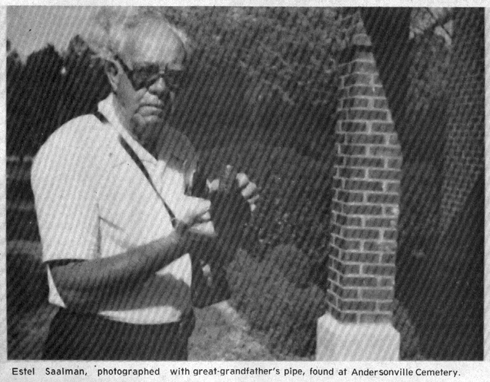June 5, 1980

Picture #1 – Estel Saalman, photographed with great-grandfather’s pipe, found at Andersonville Cemetery.
The Andersonville Prison story that appeared in the Potluck column May 4, 1978, will be remembered by many readers. At that prison, thousands of Union soldiers were imprisoned during the Civil War, and 13,669 of them died and were buried; 1,065 of them were from Ohio.
Two “Feedback” stories about Andersonville Prison just came to my attention in recent weeks from readers who read the original story, one from Estel Saalman, 11009 Columbus Ave., and the other from May C. Reinhard, 236 College Ave.
Saalman’s story is an unusual one, relating to his great-grandfather, Christian Saalman, who was one of those Union prisoners who died at Andersonville and is buried there. He was one of the thousands who died because of lack of food, impure water, diarrhea, dysentery and exposure.
Before his death he knew he could not survive, and revealed to his friend Henry DeVillez a secret; that he had hidden a $5 gold piece in his pipe, underneath the caked tobacco in the pipe’s hole. He hid it there knowing it was the only safe place for it. He requested that after his death, DeVillez keep the pipe and if he survived, deliver the fold piece to the Saalman family, back in Perry County, Indiana.
Later, after the war was over and the prisoners freed, DeVillez extracted the money, throwing the pipe away, and eventually delivered the gold piece to Saalman’s family.
DISCARDED PIPE FOUND
No one knows exactly when, but sometime later, the daughter of Christian Saalman visited the prison site after it had been declared a national cemetery, to find and view the grave.
At that time a cemetery caretaker helped her find the gravesite, and told her that he had found something that would probably be of interest to her – a pipe with the name of Christian Saalman carved on the stem. It became one of her prized possessions and remained in the family until about a year ago when Mary Wise, a great-granddaughter of Christian Saalman residing in California, brought the pipe back to Andersonville where it will remain on display in the museum.
Mr. and Mrs. Estel Saalman stopped at Andersonville Prison on the way from Florida this spring to again view the gravesite of his great-grandfather and to see the old pipe, which may be nearly 150 years old.
SAALMAN FLED GERMANY
Christian Saalman was born in Germany and fled from his native land to the United States, settling in Perry County, Indiana.
And here’s the story as told to me by Estel Saalman, about his ancestor’s flight to the U.S. The Saalman family in Germany, during the time of the kings, had been appointed by the ruling king as “Tenthers” the title being handed down through successive generation. A Tenther was one who collected a tax, or a tenth, from all the subjects, either in money or other types of property, including livestock.
Christian Saalman did not believe it was a fair means of taxation, and so when it became his turn to assume the job as the Tenther, he decided he would leave Germany and come to America. Had he remained, he would probably have been severely punished or executed.
Christian Saalman was a carpenter in Germany. Very likely, either he made the pipe or it was made by the artisan carvers and wood-workers in the Black Forest region.
The birthdate of Christian Saalman is not known, but he died July 25, 1864. He was a member of Co. D 35th Indiana Infantry. His gravesite is No. 4229, Section F, at Andersonville.
Readers may remember that Providence Spring at Andersonville Prison was the central theme of the May 4, 1978 article. When the spring gushed forth after the Christian soldiers prayed to God for water, Christian Saalman asked to be carried to the spring, that he might have a refreshing drink before dying. His wish was granted and shortly thereafter he was carried to a knoll just above the spring where he died.
KINDNESS DOWNFALL?
The fateful part of this whole story is that had Christian Saalman not been involved in an act of kindness he perhaps wouldn’t have been imprisoned at Andersonville and this story would never appeared in print.
The story, according to Estel Saalman, is that the Union forces were engaged in battle at Chickamauga and forced to retreat. Saalman and several of his army buddies fell behind as the lines retreated, and came across several other Union soldiers who had been wounded. They begged not to be left behind, so they helped evacuate them from the danger zone and found their way to a house where they could get water for those wounded.
As they approached the house, several Confederate soldiers took them captive and they were taken to Andersonville Prison.
Estel Saalman said that Henry DeVillez, mentioned soldier earlier lived to be an elderly man in Perry County, Indiana, and revealed to him many of the incidents recounted.
The accompanying photo shows Estel Saalman standing in just about the same spot where his great grand-father died, holding the treasured pipe, which may be viewed by anyone visiting the prison.
I’ll tell you the Reinhard story another issue.